AQA • Business Subjects
Latest uploads for Business Subjects at AQA. Looking for Business Subjects notes at AQA? We have lots of notes, study guides and study notes available for Business Subjects at AQA.
-
276
-
12
-
41
Courses Business Subjects at AQA
Notes available for the following courses of Business Subjects at AQA
-
Unit 1 BUSS1 - Planning and Financing a Business
-
Unit 2 BUSS2 - Managing a Business
-
Unit 3 BUSS3 - Strategies for Success
-
Unit 4 BUSS4 - The Business Environment and Managing Change
Popular books AQA • Business Subjects

Cgp Books • ISBN 9781782943532

Ian Marcourse, Nigel Watson • ISBN 9781471835803

Gwen Coates, John Wolinski • ISBN 9781471836114

John Wolinski, Gwen Coates • ISBN 9781510454996
Latest notes & summaries AQA • Business Subjects

The document on Unit Cost and Efficiency explores operational efficiency in business operations, emphasizing how effectively resources like machinery, materials, and labor are utilized to maximize outputs. It introduces LUCC (Labour, Unit Cost, Capacity, Capacity Utilisation) as critical factors for improving efficiency, with methods such as increasing capacity utilization, enhancing labor productivity, and adopting lean production techniques. The concept of unit cost is highlighted as a key ind...
- Summary
- • 3 pages's •
-
AQA•3.4 Decision making and operational performance
Preview 1 out of 3 pages
The document on Unit Cost and Efficiency explores operational efficiency in business operations, emphasizing how effectively resources like machinery, materials, and labor are utilized to maximize outputs. It introduces LUCC (Labour, Unit Cost, Capacity, Capacity Utilisation) as critical factors for improving efficiency, with methods such as increasing capacity utilization, enhancing labor productivity, and adopting lean production techniques. The concept of unit cost is highlighted as a key ind...
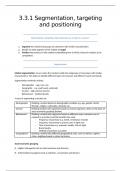
Document 3.3.1 on Segmentation, Targeting, and Positioning outlines a strategic approach in marketing. It begins with segmentation, dividing the market into distinct groups based on consumer characteristics. Targeting follows, where specific segments are selected based on factors like profitability and competitive landscape. Finally, positioning determines how a product is perceived relative to competitors, influenced by internal strengths, market conditions, and consumer perceptions. The docume...
- Summary
- • 3 pages's •
-
AQA•3.3 Decision making and marketing performance
Preview 1 out of 3 pages
Document 3.3.1 on Segmentation, Targeting, and Positioning outlines a strategic approach in marketing. It begins with segmentation, dividing the market into distinct groups based on consumer characteristics. Targeting follows, where specific segments are selected based on factors like profitability and competitive landscape. Finally, positioning determines how a product is perceived relative to competitors, influenced by internal strengths, market conditions, and consumer perceptions. The docume...
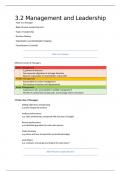
This document explores management and leadership in depth. It covers the roles of managers across different levels, leadership styles including the Blake Mouton Leadership Grid, decision-making processes such as intuition-based and scientific methods like decision trees, stakeholder management and mapping, and the Tannenbaum & Schmidt leadership continuum, which categorizes leadership styles based on managerial authority and subordinate freedom.
- Summary
- • 6 pages's •
-
AQA•3.2 Managers, leadership and decision making
Preview 2 out of 6 pages
This document explores management and leadership in depth. It covers the roles of managers across different levels, leadership styles including the Blake Mouton Leadership Grid, decision-making processes such as intuition-based and scientific methods like decision trees, stakeholder management and mapping, and the Tannenbaum & Schmidt leadership continuum, which categorizes leadership styles based on managerial authority and subordinate freedom.
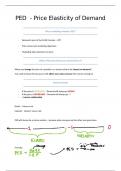
The document discusses Price Elasticity of Demand (PED) and its relevance to marketing. PED measures how changes in price affect demand, which is crucial for sales revenue. It highlights the inverse relationship between price and demand: increasing prices decrease demand, while decreasing prices increase demand. PED is always negative, reflecting this inverse relationship. Additionally, the document differentiates between elastic (demand changes significantly with price changes) and inelastic (d...
- Summary
- • 1 pages's •
-
AQA•3.2 Managers, leadership and decision making
Preview 1 out of 1 pages
The document discusses Price Elasticity of Demand (PED) and its relevance to marketing. PED measures how changes in price affect demand, which is crucial for sales revenue. It highlights the inverse relationship between price and demand: increasing prices decrease demand, while decreasing prices increase demand. PED is always negative, reflecting this inverse relationship. Additionally, the document differentiates between elastic (demand changes significantly with price changes) and inelastic (d...
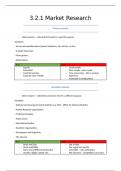
The document "3.2.1 Market Research" outlines two types of market research: primary and secondary. Primary research involves firsthand data collection for specific purposes, using methods like surveys, interviews, focus groups, and observations. It is specific and controlled but can be time-consuming and expensive. Secondary research utilizes existing data from sources such as government statistics, market research organizations, and academic institutions, which is quick and accessible but may b...
- Summary
- • 2 pages's •
-
AQA•3.2 Managers, leadership and decision making
Preview 1 out of 2 pages
The document "3.2.1 Market Research" outlines two types of market research: primary and secondary. Primary research involves firsthand data collection for specific purposes, using methods like surveys, interviews, focus groups, and observations. It is specific and controlled but can be time-consuming and expensive. Secondary research utilizes existing data from sources such as government statistics, market research organizations, and academic institutions, which is quick and accessible but may b...
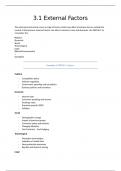
The document outlines the external factors affecting a business, categorized under the PESTLE+C framework: Political, Economic, Social, Technological, Legal, Ethical/Environmental, and Competition. These factors influence business costs and demand, with examples provided for each category. Additionally, it discusses how market conditions, competition, and environmental issues impact business operations, costs, and demand.
- Summary
- • 3 pages's •
-
AQA•3.1 What is Business
Preview 1 out of 3 pages
The document outlines the external factors affecting a business, categorized under the PESTLE+C framework: Political, Economic, Social, Technological, Legal, Ethical/Environmental, and Competition. These factors influence business costs and demand, with examples provided for each category. Additionally, it discusses how market conditions, competition, and environmental issues impact business operations, costs, and demand.
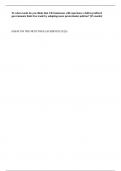
Essay on the effect of protectionist policies on UK businesses | Achieved 25/25 | AQA Business studies A-level essay
- Essay
- • 4 pages's •
-
AQA•Economic strategic position
Preview 1 out of 4 pages
Essay on the effect of protectionist policies on UK businesses | Achieved 25/25 | AQA Business studies A-level essay
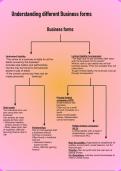
Summary of Unit 1.2 Understanding Different Business Forms Includes hierarchy summarising forms, Shareholder importance, share price significance
- Summary
- • 3 pages's •
-
AQA•Unit 1
Preview 1 out of 3 pages
Summary of Unit 1.2 Understanding Different Business Forms Includes hierarchy summarising forms, Shareholder importance, share price significance
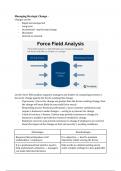
AQA A Level business unit 10 managing strategic change SUMMARY doc (detailed)
- Summary
- • 8 pages's •
-
AQA•unit 10
Preview 2 out of 8 pages
AQA A Level business unit 10 managing strategic change SUMMARY doc (detailed)
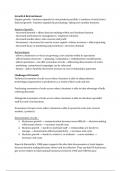
AQA A Level business unit 9 strategic methods SUMMARY doc (detailed)
- Summary
- • 9 pages's •
-
AQA•unit 9
Preview 2 out of 9 pages
AQA A Level business unit 9 strategic methods SUMMARY doc (detailed)
